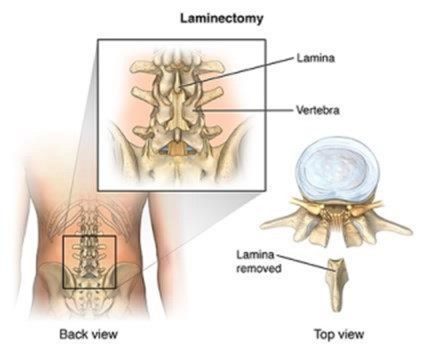A nurse is caring for a client who is postoperative following a laminectomy with spinal fusion. Which of the following actions should the nurse take?
Position the client in a high-Fowler's position if clear drainage is noted on the dressing
Monitor sensory perception of the lower extremities.
Assist the client into a knee-chest position to manage postoperative discomfort.
Maintain strict bed rest for the first 48 hr postoperative.
The Correct Answer is B
A. Positioning the client in a high-Fowler's position if clear drainage is noted on the dressing is not a specific intervention for a laminectomy with spinal fusion. The nurse should follow the surgeon's specific postoperative orders regarding positioning and wound care.
B. Monitoring sensory perception of the lower extremities is a crucial nursing intervention after a laminectomy with spinal fusion. This is to assess for any signs of neurovascular compromise or nerve damage.
C. Assisting the client into the knee-chest position to manage postoperative discomfort is not a recommended position after a laminectomy with spinal fusion. The nurse should follow the surgeon's specific postoperative orders regarding positioning.
D. Maintaining strict bed rest for the first 48 hours postoperative is not typically indicated after a laminectomy with spinal fusion. Early mobilization and ambulation are often encouraged to prevent complications and promote recovery. The nurse should follow the surgeon's specific postoperative orders regarding activity and mobility.

Nursing Test Bank
Naxlex Comprehensive Predictor Exams
Related Questions
Correct Answer is D
Explanation
A. Stretching exercises are beneficial for improving flexibility and range of motion. This however doesnt load bones to slow down osteoporosis.
B. High-impact aerobics can increase the risk of fractures in individuals with osteoporosis due to the stress on bones. It is not a recommended form of exercise.
C. Riding a bicycle is a low-impact exercise that can be beneficial for cardiovascular health, but it may not specifically address the needs of osteoporosis.
D. Walking briskly is a weight-bearing exercise that can help strengthen bones. It's a good recommendation for clients with osteoporosis.
Correct Answer is ["A","B","D","E"]
Explanation
A. Avoiding prolonged sitting helps reduce pressure on the lower back and minimizes the risk of developing back strain or pain.
B. Sleeping in a side-lying position with flexed knees helps maintain the natural curvature of the spine and reduces strain on the lower back.
D. Using padded shoe insoles can provide additional support and cushioning to the feet and lower back, helping to reduce strain.
E. Applying heat for short durations can help relax muscles and alleviate muscle tension, which can contribute to back pain relief. However, it's important not to overuse heat, so short intervals are recommended.
Whether you are a student looking to ace your exams or a practicing nurse seeking to enhance your expertise , our nursing education contents will empower you with the confidence and competence to make a difference in the lives of patients and become a respected leader in the healthcare field.
Visit Naxlex, invest in your future and unlock endless possibilities with our unparalleled nursing education contents today
Report Wrong Answer on the Current Question
Do you disagree with the answer? If yes, what is your expected answer? Explain.
Kindly be descriptive with the issue you are facing.
